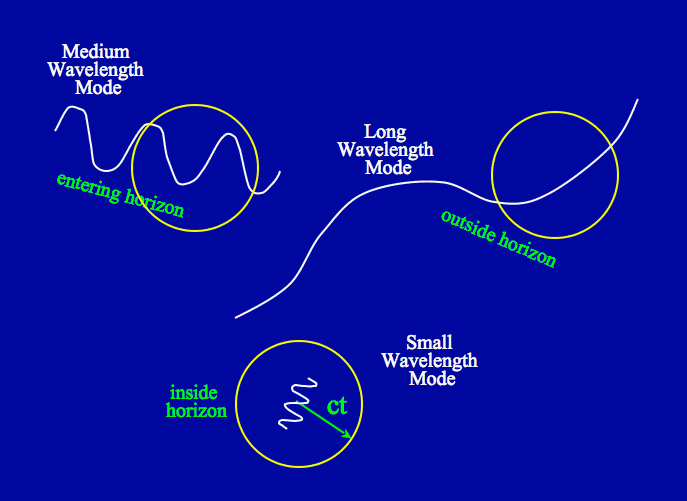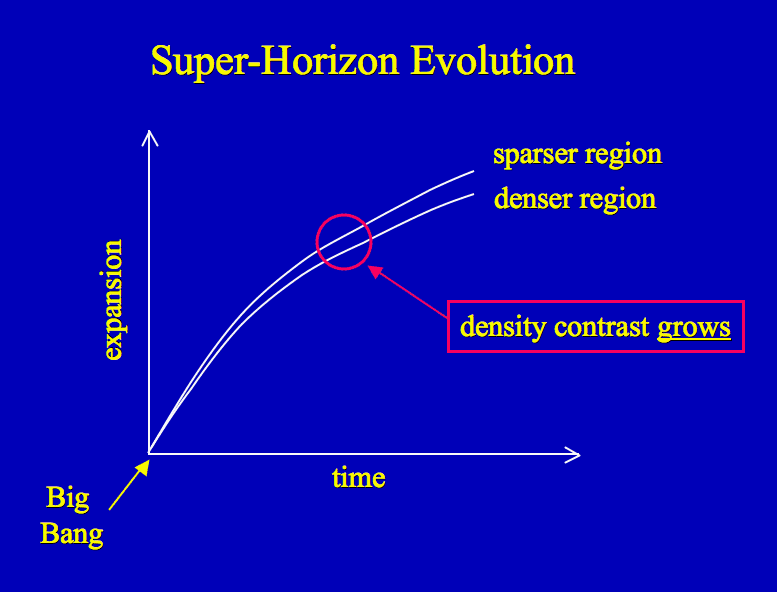
In this topic we introduce horizons — natural limits to the size of regions that can generate sound, and define pitch.
In the last movie a moving arrow indicated a 'sub-horizon' and 'super-horizon' divide. What is this? The word horizon conjures up the notion of looking out as far as one can – to the limit of visibility, where the Earth's curve hides what lies beyond. How does this concept apply to the Universe? Simple: pick a time, any time, say 1000 years after the Big Bang; how far can you see? Even in a transparent universe, there is a limit. In this case the limit is 1000 light years. Why? Because there hasn't yet been time for light to get to you from anything lying beyond. You live in a 1000 light year sphere totally unaware of what lies beyond. As time passes, this cosmic horizon gets bigger – at light-speed! After a million years, the sphere has grown to a size of 1 million light years.
Since the early universe was so foggy, why should we care about some hypothetical maximum visible distance? Because gravity also travels at the speed of light, and even though photons can't reach us from the horizon, gravity can. Why is this important? Because we want to know what forces act on each region, pushing or pulling it this way or that. So, at any moment each region "feels" the gravity from mass out to the horizon, but not beyond. The horizon therefore defines a "maximum sphere of influence" — there simply hasn't been time for any force to arrive from something outside this sphere.
In Topic 14 we will learn that the Universe is essentially born clumpy, with slight variations in density from place to place — shallow hills and valleys of different size and orientation scattered randomly across space. The sketch below shows three of these hills and valleys – one small, one medium and one large.
 |
Also shown are circles (spheres in 3D) to indicate the horizon. How big are these spheres? Well, after "t" years they have grown at light-speed and have radius "ct" light years. So, at this time small clumps (say, 20% of ct) sit well inside the horizon and feel their own gravity, while large clumps (say, 5 ct) still sit outside the horizon and cannot yet feel their own gravity. Since the horizon grows at light-speed, there comes a moment when each clump size "enters the horizon" and begins to feel its own gravity. The Universe's clumps, therefore, divide into two categories: sub- and super-horizon size. These evolve quite differently, as we shall see.....
As you might imagine, once a region begins to "feel" its own gravity, it starts to respond and change. We'll come to these sub-horizon changes in a moment, but first let's ask whether large super-horizon regions can change. Although they can't change internally, they do participate in the cosmic expansion, and because of this the entire population of super-horizon clumps does evolve. Here's why. Emerging from creation, each region expands at a rate that depends on its density — denser regions expand a bit more slowly, while sparser regions expand a bit more rapidly — it's as if the denser/sparser regions act like miniature closed/open universes, each with their own expansion history. As time passes, therefore, the denser regions "lag" further behind the sparser regions, and the density contrast steadily increases. Thus, overall, the super-horizon "landscape" gradually gets rougher. You can see this nicely in the last movie, which shows the entire sound spectrum getting louder with time, including super-horizon scales.
 |
What happens to clumps smaller than the horizon, where gravity connects every part to every other? Not surprisingly, each location begins to move in the direction that gravity dictates: "down hill", towards denser regions, into valleys. What happens next depends on the player - light, atomic matter, or dark matter. The story for light and atomic matter was told back in topic 6 — both fall into valleys where they over-compress and bounce out again, only to over-shoot and fall back in again — a pressure oscillation begins and sound commences.
In contrast, dark matter feels no pressure, so it simply falls into valleys without any oscillation. One detail: before 50,000 years, it is radiation that molds gravity, and so dark matter never has time to build up in a valley — valleys and hills keep interchanging as radiation oscillates. After 50,000 years, it is dark matter which molds gravity, so when it falls into a valley the valley gets deeper, which pulls in yet more dark matter, and the roughness keeps growing (study the purple line in this figure from topic 11).
Returning to the acoustic perspective: we find there is a strict maximum size for regions which generate sound: the horizon size. Why? Because it is gravity that drives sound, and gravity cannot act across distances greater than the horizon size. Since the horizon size grows at light-speed, the regions generating sound also grow larger, and ever longer wavelengths can enter the mix. Ultimately, this is why the sound of the new-born Universe opens with a descending scream.
We've just learned that the longest sound wavelength grows in response to a growing horizon size, which in turn gives us the descending scream. However, this cannot be the full story. Take a close look at the musical version of the descending scream. If the longest wavelength strictly followed the horizon size, the pitch would keep descending. But it doesn't. Instead, it begins to slow its descent near 100,000 years, and levels off just past fog clearing. To understand this, we need to consider not the speed of light, but the speed of sound.
Consider the longest possible wavelength. Although the gravitational force which drives this wave spans the entire light horizon, the wave itself builds via pressure forces, which travel at the speed of sound. The longest wavelength is set, therefore, by the distance sound can travel since the Big Bang, not the distance light can travel. This distance is called, not surprisingly, the sound horizon, and is always smaller than the light horizon, for the simple reason that sound travels more slowly than light. The sound horizon grows in an interesting way: first at a constant 60% of light speed; it then begins to slow down; then it suddenly halts, freezing at 220,000 light years. This growth of the sound horizon size now nicely matches the pitch history of the descending scream — a steady drop, tapering off, at first slowly and then dramatically. Let's follow this by looking at the actual sound speed...
We all learned in high school that when it comes to motion, sound and light are like the tortoise and the hare — one crawls while the other zooms. Is this still true in the early Universe? Well... no... and yes.
To understand how fast sound moves one needs to compare the force trying to move the gas (pressure) and the resistance to that force (inertia, or density). Thus, sound moves quickly in a high-pressure light-weight gas, but slowly in a low-pressure dense gas (see here for details). What about the primordial gas, how did its pressure and density compare? First, recall that this foggy gas was radically different from the gas in our atmosphere — in particular, light played an important role. Second, conditions were changing with time, giving three distinct periods to consider.
For the first 50,000 years or so light dominates both pressure and density. Since light has incredibly low density compared to its pressure, this gas has a very high sound speed — about 0.6c (60% of light's speed). As time continues, atomic matter contributes more to the total density, weighing it down and slowing the sound speed. Finally, around 400,000 years the fog clears and radiation's contribution to the pressure drops to zero. With pressure now arising only from atomic gas, the sound speed plummets to around 10 km/s, the sound horizon comes to a screeching halt and freezes at about 220,000 light years.
This section has identified an important aspect of sound creation in the early Universe — sound waves must originate within regions that are in "pressure contact" i.e. within regions smaller than the sound horizon. Although there are much larger pressure variations, originating from a much earlier time, these super-horizon variations are still 'frozen', unable to interact. In a sense they are waiting for the sound horizon to encompass them, so that they can then become sound.
Since the sound horizon halts its expansion just when the fog clears, one might ask how big this horizon appears on the microwave sky, and whether it corresponds to any feature in the CMB sound spectrum? Yes! Of course it does — 220,000 light years appears 1° across in the sky and corresponds to the peak of the fundamental. The size of the fundamental arises from a single wave moving at the speed of sound for the first 400,000 years – it is the sound horizon at the time of the CMB.
Notice, then, that all the patchiness seen by the 1992 COBE satellite (resolution 7°) is non-acoustic, super-horizon patchiness. Only higher resolution CMB observations (e.g. WMAP) have been able to probe sub-horizon sizes to 'hear' the cosmic sounds. Notice also that the light/gravity horizon, at about twice the sound horizon, is still only 2°, and regions larger than this should be profoundly independent. The fact that the CMB is so uniform tells us there is yet more to the story....